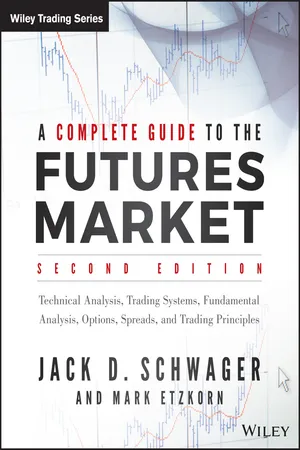
A Complete Guide to the Futures Market
Technical Analysis, Trading Systems, Fundamental Analysis, Options, Spreads, and Trading Principles
Jack D. Schwager, Mark Etzkorn
- English
- ePUB (handyfreundlich)
- Über iOS und Android verfügbar
A Complete Guide to the Futures Market
Technical Analysis, Trading Systems, Fundamental Analysis, Options, Spreads, and Trading Principles
Jack D. Schwager, Mark Etzkorn
Über dieses Buch
The essential futures market reference guide
A Complete Guide to the Futures Market is the comprehensive resource for futures traders and analysts. Spanning everything from technical analysis, trading systems, and fundamental analysis to options, spreads, and practical trading principles, A Complete Guide is required reading for any trader or investor who wants to successfully navigate the futures market.
Clear, concise, and to the point, this fully revised and updated second edition provides a solid foundation in futures market basics, details key analysis and forecasting techniques, explores advanced trading concepts, and illustrates the practical application of these ideas with hundreds of market examples. A Complete Guide to the Futures Market:
- Details different trading and analytical approaches, including chart analysis, technical indicators and trading systems, regression analysis, and fundamental market models.
- Separates misleading market myths from reality.
- Gives step-by-step instruction for developing and testing original trading ideas and systems.
- Illustrates a wide range of option strategies, and explains the trading implications of each.
- Details a wealth of practical trading guidelines and market insights from a recognized trading authority.
Trading futures without a firm grasp of this market's realities and nuances is a recipe for losing money. A Complete Guide to the Futures Market offers serious traders and investors the tools to keep themselves on the right side of the ledger.
Häufig gestellte Fragen
Information
PART I
Preliminaries
CHAPTER 1
For Beginners Only
If a little knowledge is dangerous, where is the man who has so much as to be out of danger?—Thomas Henry Huxley
■ Purpose of This Chapter
■ The Nature of Futures Markets
- The futures contract is standardized; hence, the farmer does not have to find a specific buyer.
- The transaction can be executed virtually instantaneously online.
- The cost of the trade (commissions) is minimal compared with the cost of an individualized forward contract.
- The farmer can offset his sale at any time between the original transaction date and the final trading day of the contract. The reasons this may be desirable are discussed later in this chapter.
- The futures contract is guaranteed by the exchange.
■ Delivery
■ Contract Specifications
- Exchange. Note that some markets are traded on more than one exchange. In some cases, different contracts for the same commodity (or financial instrument) may even be traded on the same exchange.
- Ticker symbol. The quote symbol is the letter code that identifies each market (e.g., ES for the E-mini S&...